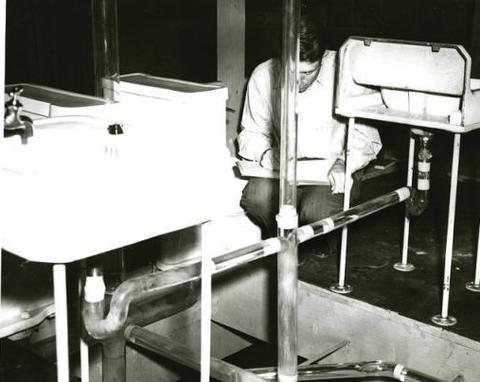The Bureau’s 60-Year-Old Urban Legend

NIST plumbing research, circa the 1940s.
“A plumber wrote to the Bureau of Standards saying that he had found hydrochloric acid good for cleaning out clogged drains.
The bureau wrote back, ‘The efficacy of hydrochloric acid is indisputable, but chlorine residue is incompatible with metallic permanence.’ The plumber replied that he was glad the bureau agreed. The bureau tried again, writing, ‘We cannot assume responsibility for the production of toxic and noxious residues with hydrochloric acid, and suggest that you use an alternate procedure.’ The plumber again said that he was glad the bureau agreed with him. Finally, the bureau wrote to the plumber, ‘Don’t use hydrochloric acid; it eats the hell out of the pipes.’ ”
For more than 60 years now, some version of the above story has been repeatedly published. It’s been retold in over a thousand books, journal articles and newspaper stories, and has even been mentioned during congressional hearings. The story is an amusing example of the importance of using clear, non-technical language for effective communication.
But who was the bureau letter writer whose poor choice of words led to such confusion? After some research into the matter by the NIST Research Library, we’ve concluded that this person most likely never existed. And the story itself is probably a work of fiction.
As far as we can tell, the story first appeared in February 1947 simultaneously in a number of different newspapers nationwide. These newspaper articles carried no byline and did not name any specific individuals involved in the story. Each newspaper changed the story details somewhat. In one paper the unnamed plumber is from New York, while another paper states that the plumber was “of foreign birth.”
It’s unclear where the story originated, but journalists of the day probably found it too good not to use, despite its vague provenance. The story fit the public stereotype of dealing with government agencies in general, and with scientists in particular.
According to the book Measures For Progress: A History of the National Bureau of Standards, in March 1947, just one month after the plumber story first appeared in newspapers, a congress- man retold the story to NBS Director Edward Condon after the latter had failed to satisfactorily explain the work of the bureau to an appropriations committee.
A few years after its initial publication, the story got a big boost in popularity when it was included in the 1954 book Power of Words by Stuart Chase. This manual on clear speaking and writing became influential in the communications field, and is the most common source cited when the plumber story has been republished in subsequent works. Chase provided no source for the story in Power of Words, simply stating that he has “told this story before.”
And the story keeps on being told. As recently as 2012, Cambridge University Press published the seventh edition of the textbook How to Write and Publish a Scientific Paper, which uses the plumber story as a warning about the overuse of jargon.
Urban legends are modern folktales that are often used to impart a moral lesson. With the plumber story, NBS is the butt of a joke illustrating the challenges in communicating technical information in an accurate but understandable way to the general public. While it’s unfortunate that a fictitious story about NBS is used, the lesson of the story is still one that should be taken to heart. And perhaps this story embodies a second lesson as well, one for the newspaper reporter: If you don’t check your sources, you will confuse the hell out of people!
Originally published in NIST Connections: A Newsletter for NIST Employees and Associates, September 2015, p. 8.
Contacts
-
(301) 975-2789

